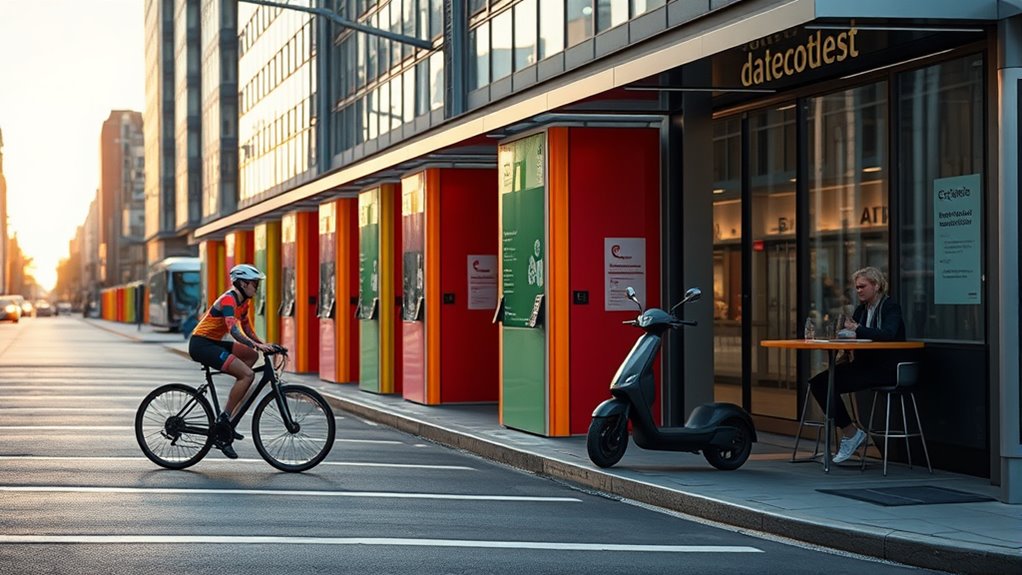Micro-commutes are intentional, brief trips that help create strong habit loops by turning ordinary moments into opportunities for productivity and reflection. When you align these short trips with your daily goals, you turn mundane routines into productive habits, like walking while brainstorming or practicing mindfulness. Over time, these micro-movements become second nature, boosting your efficiency. Keep exploring how you can implement micro-commutes to make your routines stick more effectively.
Key Takeaways
- Micro-commutes create consistent habit loops by linking short trips with specific routines or goals.
- Repeating micro-commutes helps reinforce neural pathways, making productive behaviors automatic over time.
- Incorporating mindful activities during micro-commutes strengthens mental associations and habit formation.
- Scheduling micro-commutes intentionally aligns them with daily goals, boosting their likelihood of becoming ingrained habits.
- Over time, these small routines build sustainable habits that enhance overall productivity and well-being.

Micro-commutes are short, intentional trips that can transform your daily routine and boost productivity. Instead of wasting time stuck in traffic or waiting in line, you can leverage these brief journeys to optimize your day. They’re perfect for breaking up long stretches of work and giving your mind a quick reset. By intentionally planning these micro-commutes, you create a series of small habits that can notably improve your overall time management. This approach allows you to carve out moments for reflection, learning, or simply re-energizing, all without adding extra hours to your schedule.
Micro-commutes transform routines, boost productivity, and create small habits for better time management without extra hours.
When you incorporate micro-commutes into your routine, you’re fundamentally creating productivity hacks that reinforce good habits. For example, walking or biking to nearby errands or meetings turns mundane tasks into opportunities for physical activity and mental clarity. These small, purposeful trips help you stay more organized because they encourage a clear separation between work and personal time. Over time, these habit loops become ingrained, making it easier to stick to routines that promote efficiency and well-being. The key is to be deliberate about each micro-commute—view it as an investment in your productivity and mental health.
To maximize the benefits, plan your micro-commutes around your daily goals. If you have a big project to work on, consider taking a walk to brainstorm ideas or listen to an educational podcast that enhances your skills. When you schedule these short trips intentionally, you’re not just filling time—you’re transforming it into productive moments. You might also use them to practice mindfulness or quick journaling, helping you clear your mind and set intentions for the next task. These small, consistent habits create powerful loops that reinforce positive behaviors and keep you moving forward more efficiently.
The beauty of micro-commutes is that they’re flexible and easy to integrate into any schedule. Whether it’s a quick walk around the block or a bike ride to the store, these trips can be tailored to fit your life. Over time, they develop into habit loops that make productivity feel more natural and less forced. You’ll find that as these routines become second nature, your overall time management improves because you’re making the most of every moment. Additionally, understanding habit formation can help you intentionally design these routines for long-term success. Micro-commutes aren’t just about saving time—they’re about transforming how you approach daily tasks and creating sustainable habits that stick long-term.
Frequently Asked Questions
How Can Micro-Commutes Be Personalized for Different Lifestyles?
You can personalize micro-commutes by applying tailored personalization strategies that fit your unique lifestyle. For example, if you’re busy, incorporate quick, focused activities like listening to audiobooks or podcasts. If you prefer calm, add mindfulness exercises. Integrate these micro-commutes seamlessly into your daily routine, making them a natural part of your lifestyle. This customization helps guarantee your micro-commutes remain engaging, effective, and easy to stick with long-term.
What Technology Tools Support Micro-Commutes Effectively?
Sure, virtual reality and wearable devices are your best friends for micro-commutes. They make your tiny trips feel grand—who needs a real walk when you’ve got VR to escape? Wearables track your steps and habits, turning even a short stroll into a high-tech adventure. These tools support micro-commutes by blending tech with daily routines, making it easier to stay engaged and motivated, even if you’d rather stay on your couch.
Are Micro-Commutes Suitable for All Age Groups?
Micro-commutes can suit most age groups, but you should consider age adaptability and physical limitations. Younger individuals often find them easy and engaging, while older adults may need modifications for comfort and safety. If you or someone you know faces mobility challenges, adapt micro-commutes with accessible routes or activities. Overall, with proper adjustments, micro-commutes can be a beneficial habit for nearly everyone, regardless of age.
How Do Micro-Commutes Impact Long-Term Habit Formation?
Micro-commutes boost long-term habit formation by reinforcing routines through small, consistent actions. When you incorporate micro-commutes into your daily life, they help solidify new habits by creating predictable patterns, making routine adaptation easier over time. These brief, intentional trips strengthen your commitment and embed behaviors more deeply, ultimately leading to sustained habit reinforcement that sticks. You’ll find it easier to maintain positive changes with micro-commutes integrated into your routine.
Can Micro-Commutes Replace Traditional Commuting Methods?
Like a whisper of the morning breeze, micro-commutes can indeed replace traditional methods if integrated thoughtfully. You can contribute to smarter urban planning and enjoy environmental benefits by walking or biking short distances. These micro-moves reduce congestion and pollution, creating healthier cities. Embracing micro-commutes helps you build sustainable habits, transforming daily routines into positive, impactful choices. It’s a small step with the power to reshape your city’s future.
Conclusion
By incorporating micro-commutes into your daily routine, you can turn small moments into powerful habit loops. Did you know that just a five-minute walk can boost your mood and focus? Embracing these tiny habits not only improves your well-being but also creates lasting change over time. So, next time you have a break, choose to step outside — those brief micro-commutes could be the key to a healthier, more productive you.









